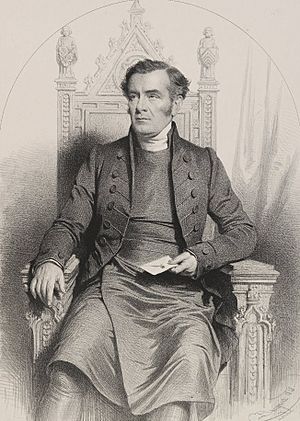John Merewether facts for kids
Quick facts for kids
John Merewether
|
|
|---|---|

John Merewether, 1848 engraving by Charles Baugniet.
|
|
| Born | 1797 Marshfield, Gloucestershire
|
| Died | 4 April 1850 Madeley, Shropshire vicarage
|
| Nationality | British |
| Alma mater | The Queen's College, Oxford |
| Occupation | Dean of Hereford |
| Known for | antiquary |
John Merewether (born 1797, died 1850) was an important English church leader. He was the Dean of Hereford starting in 1832. He was also known for studying old things and history, making him an antiquary.
Contents
Early Life and Church Work
John Merewether was born in 1797 in Marshfield, Gloucestershire. His father was John Merewether from Blackland, Wiltshire.
He went to The Queen's College, Oxford in 1814. He earned his first degree in 1818. Later, he received higher degrees in 1832. In 1820, he became a priest. He worked in churches in Gillingham, Dorset and Hampton, Middlesex.
Helping the Royal Family
While working in Hampton, Merewether helped build a small church in Hampton Wick. This work caught the attention of the Duke of Clarence. The Duke later became King William IV in 1830.
In 1824, Merewether became a chaplain to the Duchess of Clarence. She would later become Queen Adelaide. In 1828, he was given a church job in New Radnor. Then, in 1832, he became the Dean of Hereford.
Challenges as Dean
The Hereford Cathedral needed many changes. Merewether was known for being strong-willed. This sometimes led to disagreements with others.
In 1833, King William IV appointed Merewether as a deputy clerk. The King also asked his Prime Minister, Lord Melbourne, to help Merewether advance in his career. In 1836, Merewether also became the vicar of Madeley, Shropshire.
When King William IV died, he wished for Merewether to become a bishop. However, the new Prime Minister, Robert Peel, did not follow this wish.
A Big Disagreement
In 1847, Merewether strongly opposed Renn Dickson Hampden becoming the Bishop of Hereford. He wrote a long letter to Prime Minister Lord John Russell. In the letter, he said he would vote against Hampden.
The Prime Minister sent a short reply. It said Merewether's plan would go against the law. In the end, Merewether refused to sign the official document for Hampden's election.
Studying History and Old Things
Merewether was very interested in history and old objects. In 1836, he became a member of the Society of Antiquaries of London. He wrote articles about discoveries made during the restoration of Hereford Cathedral.
In 1838, he also became a member of the Royal Society. In 1843, he wrote a report about the condition of Hereford Cathedral. It included notes on old statues and drawings of the building.
Exploring Ancient Sites
Merewether was an active member of the Archæological Institution. He did important work in Wiltshire. After he died, his notes were published in a book called Diary of a Dean. This book described his study of Silbury Hill and other ancient burial mounds in Wiltshire. The book included his own drawings of human remains, stone tools, and pottery found.
In 1849, Merewether led excavations at 33 round barrows, West Kennet Long Barrow, and Silbury Hill. He was very energetic in his archaeological work.
Later Life and Legacy
John Merewether died on April 4, 1850, at the vicarage in Madeley. He was buried in Hereford Cathedral. Five stained-glass windows were placed in the cathedral in his memory. They honored him for his strong support in restoring the sacred building.
Family Life
John Merewether and his wife, Mary Ann Baker, had six sons and three daughters. Mary Ann Merewether passed away in 1879.
He was the great-grandfather of Dr. Edward Merewether. He was also the brother-in-law of the famous organist and composer Samuel Sebastian Wesley.

